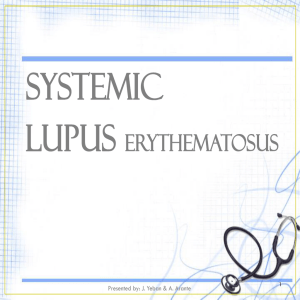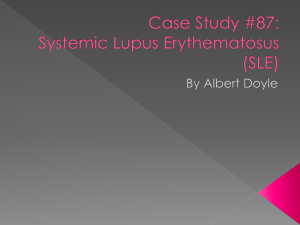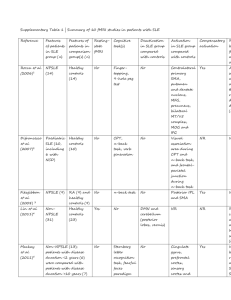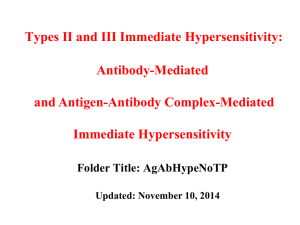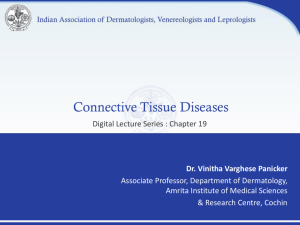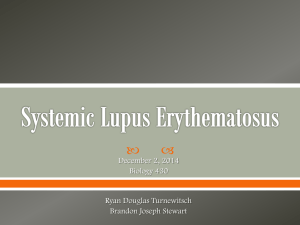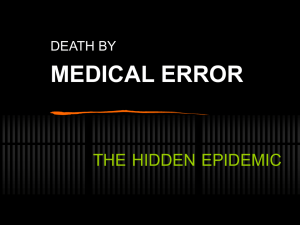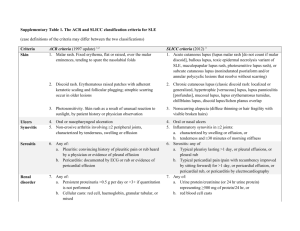7-Dr.Alhaddab f
advertisement
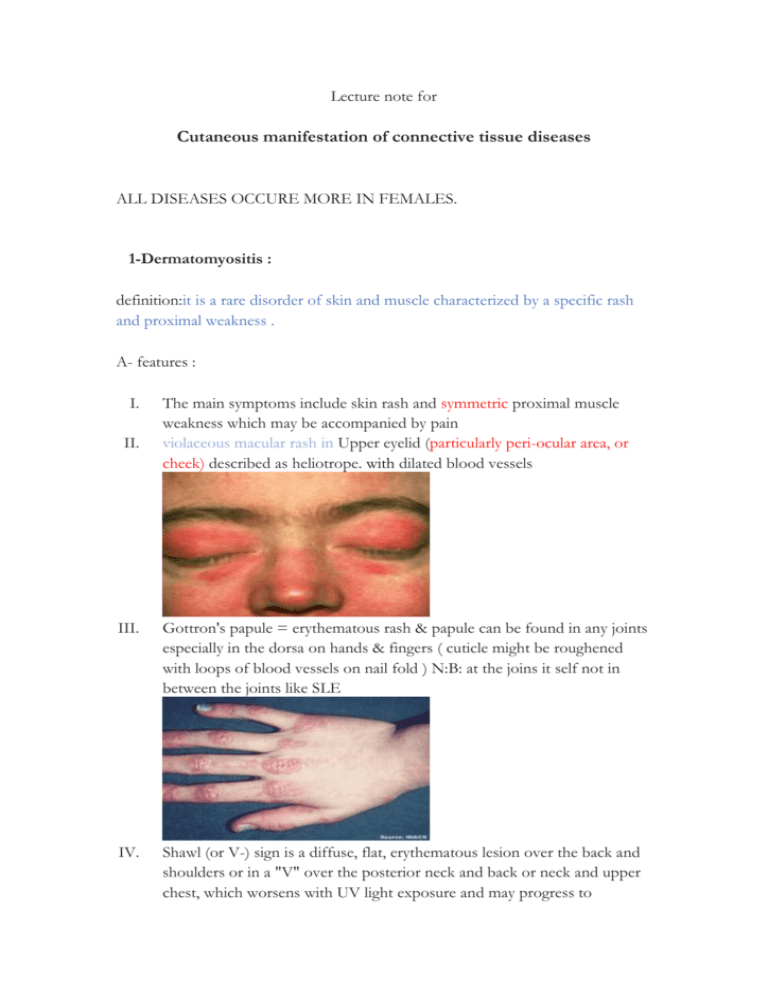
Lecture note for Cutaneous manifestation of connective tissue diseases ALL DISEASES OCCURE MORE IN FEMALES. 1-Dermatomyositis : definition:it is a rare disorder of skin and muscle characterized by a specific rash and proximal weakness . A- features : I. II. The main symptoms include skin rash and symmetric proximal muscle weakness which may be accompanied by pain violaceous macular rash in Upper eyelid (particularly peri-ocular area, or cheek) described as heliotrope. with dilated blood vessels III. Gottron's papule = erythematous rash & papule can be found in any joints especially in the dorsa on hands & fingers ( cuticle might be roughened with loops of blood vessels on nail fold ) N:B: at the joins it self not in between the joints like SLE IV. Shawl (or V-) sign is a diffuse, flat, erythematous lesion over the back and shoulders or in a "V" over the posterior neck and back or neck and upper chest, which worsens with UV light exposure and may progress to V. VI. VII. poikiloderma (telangiectasia and atrophy, (dappled skin)). Dysphagia occurs in 30% of patients, because of esophageal muscle involvement … and respiratory difficulties can occur. (diaphragm+ intercostal) Photosensitivity + telengactesia which could be a sign of malignancy ( esp. GIT malignancy + and to some extent ovarian ca& prostate and breast ) , so it's important to check about that in patients who are: 1. older than 50 yrs 2. had a history of symptoms of malignancy 3. Proximal muscle weakness ( triceps , quadriceps ) In children, dermatomyositis may leave severe restriction of limb movement because of muscle calcification. B- Pathology: Histological changes similar to SLE. There are: 1.free RBCs ( from dilate blood vessels ). 2.melanin 3.muscle fiber degeneration and internalization of sarcolemmal nuclei 4.thin atrophic epidermis with liquefaction in basal layer. B- Diagnosis: typical presentation ( rash + weakness ) raised circulating muscle enzymes(SGOT, SGPT, CK, aldolase) biopsy or EMG (biopsy is mainly taken from proximal muscle group especially extensors ) C- Management : removal of malignancy if present improve muscle weakness. i. Topical steroids: if only cutaneous (Skin is slowly improve ) ii. Systemic steroid: if the muscle is involved (doesn’t improve the skin ) iii. Immuonosuppressive agents may be of value(azathioprine, methotrexate…) D- Follow up : for muscle by monitoring power & CK level. *features common to all types of lupus erythematosus LE: 1.lichenoid tissue reaction.2.epidermalhyperkeratosis.3.patchy thickening of the angular layer. The presence and type of circulating auto antibodies is the major criterion for diagnosis. 2-systemic lupus erythematosus (SLE) A- features: I. II. III. IV. a systemic disease manifested on skin as macular rash affecting the face at T zone & spares the nasolabial folds, so called “butterfly area” . provoked by sunlight. In hands, it spares the joint area usually (between the joints ) Patchy, diffuse hair loss is a recognized feature. But, permanent hair loss & scarring is unusual, and the lesion is less florid ( usually seen in CDLE. See below) SLE with photosensitivity, it will result in lichenification from sun exposure which may lead to skin lymphoma. B- Diagnosis: …typical presentation(unwell, butterfly rash provoked by sun) …(to confirm Dx: ANA(antinuclear antibody),anti double stranded DNA antibody.) Management : i. potent steroid , to prevent scaring (but in the face when don’t use super potent steroid because it may cause thinning of the epidermis, folliculitis & telangictasia) . ii. immunosuppressive drug ( systemic steroid, cyclophsphamide, azathioprine, &chlorambucil) iii. Sun avoidance and therapy with sunscreens, topical corticosteroids at night, and antimalarial agents is usually effective. iv. skin graft if it is in small area v. maintenance with low dose steroid. 3- Discoid lupus : A- definition: chronic purely cutaneous ( 90% of cases) disorder characterized by red scaly plaque on light exposed areas (photosensitivity), which heal with scarring. B- features: I- Chronic, raised, scarring, atrophy producing, photosensitive dermatosis. The disease is not common, but causes concern because the face is the most commonly affected site and because of permanent scarring that may be seen.(usually multiple plaques). II- IIIIV- V- VI- May occur in patients with systemic lupus erythematosus (SLE), and some patients (< 5%) with CDLE progress to SLE. Patients with DLE rarely fulfill 4 or more of the criteria used to classify SLE. The primary lesion is an erythematous papule or plaque with slight to moderate scaling . As the lesion progresses, the scale may thicken and become adherent to underlying epidermis (carpet-tack sign), and run into hair follicle and pigmentary changes may develop, with hypopigmentation in the central or inactive area and hyperpigmentation at the active border.(annular plaque) ANA almost positive with systemic lupus BUT notalways with discoid lupus > Skin biopsy to confirm the Dx In the scalp it may cause scarring permanent alopecia so, we treat it agressivly by either 1- intralesional 2- systemic steroid ( N:B: Squamous cell carcinoma is a complication of old scar ( over years ) There is no systemic upset…In the winter months the problem become quiescent. investigation: 1. perform ANA to rule out SLE 2. skin biopsy to confirm Dx treatment: 1. protective clothing. 2. Moderate to strong topical steroid and intralesional steroid. 3. Anti malarials like chloroquine and hydroxychloroquine(cause ocular toxicity) 4. Resistant cases, immunosuppressives( azathioprine, cyclosporine A, mycopheolate). 5. Oral gold and retinoids 6. Cosmetic camouflage (covermark, dermablend) 4-Sub-acute cutaneous lupus (SCLE) : A. definition& features: 1. it's a variant of LE in between SLE and discoid lupus in photosensitive patients with +veAntiRho(60%) & AntiLA (40%) but not ANA 2. Multiple red macules and plaques on exposed and coverd skin persist throughout the year. scaling and scarring are unusual. 3. Upper part of trunk often involved with diffuse widespread lesions. 4. Most have no other organ involvement except mild arthropathy. 5. DDx: chilblains and erythema multiforume, light eruption and photosensitive drug eruption. 6. Biopsy and immuoflurescence studies are helpful. 7. Treated by topical screens and systemic antimalarials . systemic steroid may be needed. B. Neonatal lupus : i. Rare annular erythematous plaques with a slight scale characterize neonatal lupus erythematosus and appear predominately on the scalp, neck, or face (typically periorbital in distribution , but similar plaques may appear on the trunk or extremities. ii. usually for baby of Anti-Rho +ve mother . iii. +veAntiRho&AntiLa in 60% & 40% respectively. iv. If patient has photosensitivity sunblock You must refer him to cardiologist ( because of high risk to have complete heart block ). C. Antiphospholipid antibody syndrome: - associated with cerebrovascular accidents, MI, thrombotic episodes. - livedo pattern usually in the thighs, the patients have antiphospholipid antibody. - ulcers, phlebitis and gangrene may be present. 5- Morphea Purely cutaneous commonly in children. appearance of scar-like band. Features: 1. Morphea is a rare condition also known as localized scleroderma. It is a disease characterized by patches of red or purple or white hot , firm skin that appear mainly on the torso, arms, trunk, and legs with well marked red or violet margins . Unlike systemic sclerosis, morphea lacks features such as sclerodactyly, Raynaud phenomenon, nailfold capillary changes, telangiectasias, or progressive internal organ involvement. calcification may develop. 2. Morphea can present with extracutaneous manifestations, including fever, lymphadenopathy, arthralgias, and central nervous system involvement, and laboratory abnormalities, including eosinophilia, polyclonal hypergammaglobulinemia, and positive antinuclear antibodies. 3. En coup de sabre: (depressed atrophic linear plaque cause alopecia and may cause growth irregularities of the skull in children) is a type of linear scleroderma that presents on the frontal or frontoparietal scalp due to inflammatory disease ( Morphea). 4. In Morphea, there's loss of all skin appendages which is the major feature in histology. 5. Other histological features: collagen boundless are larger, epidermis tend to be thin and atrophic, and the normal difference between the papillary and reticular dermis is lost. (N:B: morphea + internal organ involvement = systemic sclerosis , it can affect the bone and muscle If it is so severe) B. management: no specific therapy: potent corticosteroids(topical or intalesional). phototherapy. photo chemotherapy. surgery Diagnosed by clinical appearance. 6- Systemic scleroderma: Progress accumulation of collagen, fibrosis, loss of motility. Transforming growth factor beta 1 is thought to be involved in the pathogenesis . A: features: 1. females are more commonly affected. 2. In hands and feet: initially swollen and tight shiny atrophic skin, which is bound firmly to the subcutaneous tissue, and resorption of the distal phalanges and subcutaneous calcification ma occur.. 3. In mouth: the same. and in XR there is wide peridontal membrane. 4. In face: line free forehead, small beaked nose, small mouth, radial furrowing around the lips and telangiectasia in severe case. 5. Sclerodactyly is a component of the CREST variant of scleroderma CREST is an acronym that stands for C= calcinosis, R= Raynaud's phenomenon, E= esophageal dysmotility, S= sclerodactyly, T= telangiectasia.) 6. Pathology : fat become closer to the epidermis, the pathological process involves fibrosis and vasculature, and Skin appendages is not involved ( unlikeMorphea which affect skin appendages also ) 7. Laboratory findings: Associated with antiscleroderm70, anticentromere antibody& ANA 8. Diagnosis : clinically(facial appearance)…. Confirmatory tests: auto antibody screen, hand and jaw XR, barium swallow, and respiratory function test. . 9. Rx as the doctor said: ]the treatment is symptomatic [ 10. Drugs used(as written in the book): 1. Immunosuppressives -in addition to steroids(methotrexate, cyclophosphomide, cyclosporine A, photopheresis UVA). 2. Antifibrotics: (penicillamine, colchicicine, gamma interferon) 3. Vasodilators: Ca++ channel blockers (nifedipine ,prstacyclins). 4. Systemic steroids: in sever renal or respiratory involvement. (renal involvement is the most serious complication). 5. Management of raynauds disease: Prostacyclins, nifepidine, ketanserin. *Mixed connective tissue disease: - some features of both LE and systemic sclerosis.(symptomatic treatment). - the auto antibody is U1-RNP. 7- Necrobiosis lipoidica (this topic is included in dr. al-mohaisea lecture). A. features: 1) shiny atrophic red to yellowish plaque with telangiectasia mainly over the shin. 2) Could be ulcerative. 3) Check for diabetes because it strongly associate with it.(t may be called necrobiosislipoidicadiabeticorum (NLD) ) B. Rx : topical , injection ( Rx for the underlying cause) For ulcerated lesion 1- systemic +topical 2- cyclosporine 3- grafting(surgery) 8- Pyoderma Gangrenosum : (included briefly in dr. al- mohaisea lecture) A. Features: Ulcerative ,necrotic ulcer become bigger with debridement. Associated with IBD , hematologic malignancy ( sweat gangrensum come with hematologic malignancy). (N:B:)* pathrgy: pustules in the sites of trauma. Either a subnormal response to an allergen or an unusually intense one in which the individual becomes sensitive not only to the specific substance but to others, so be careful and don't send the patient to surgery for excision which may extent the lesion. ( in other word: pathergy: when you prick the skin with sterile needle it will develop a pustule which will develop into ulcer ) B. Rx: o high high dose of systemic steroid. o Treat underlying disease like IBD… 9- Lichen sclerosis et atrophicus : A. features: it's atrophic (sclerosing or fibrosing) condition commonly of the vulva and anus (figure of 8 ), frequently associated with morphea it's a white atrophic glazed areas of skin mainly affecting genitalia. it could affect penis ( rare) especially non circumcised men. in males (rare ), the disease may take the form of whitish thickening of the foreskin, which cannot be retracted easily. also it affects post menopausal women but it is more young women (commonest) They usually complaining of difficult urination(genital discomfort and bleeding) There is shrinkage of the genital tissue and increase melanin in the affected sites. Some lesions are asymptomatic, others may cause ulcer, pain or pruritus. Extra genital lesions commonly around the neck and upper back. Incidence of about 3% malignant change. B. Diagnosis : clinically. Biopsy may be required( loss of all appendages, epidermal atrophy, homogenization of the collagen) C. Rx: Unsatisfactory! supra potent steroid ( in male remove foreskin if it's affected ) Supra potent steroid (not estrogen as the book said) usually not given for genital disease because they cause thinning & stria BUT in this case we have to give them to avoid risk of urethral constriction.
